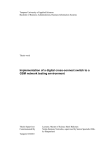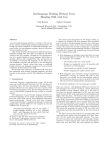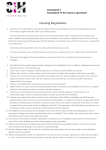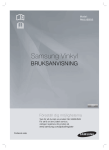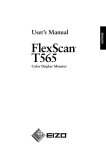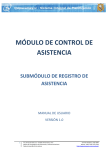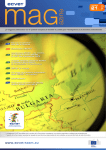Download UNINtrTT
Transcript
UNINtrTT Katalogtjenesten c,/o Universitetet i Oslo/USIT Postboks 1,059 - Blindern 0316 oslo E-PosL [email protected] Velkommen som brukerorganisasjon av katalogtjenesten ¡ UNINETT UNINETT har mottatt registreringssþema for registrering av organisasjonen deres i den elektroniske katalogen. InformasJonen fra det insendte regis-treringss$emaet er nå lagt inn i katalogen og dere er velkommen til å ta katalogtJenesten f bruk og annonsere den ovenfor egne brukere. Som vedlegg til dette brevet følger en del informasjon vi håper vil være nyttig for dere når dere nå skal ta i bruk den elektroniske katalogtjenesten: En kopi av en artikkel som gir en introduksjon til grunnleggende aspekter ved katalogtjenesten: Juha Heinänen: Intodtrctionta the OSI Directary, NORDUNET 1989. Man kan også finne en introduksjon til katalogtjenesten i kapittel 3 i den vedlagte manualen for 8UrPU. Et dokument som går $ennom UNINETTs strategi for å etablere en hvite siders katalogtjeneste, tar opp ulike måter å ta i bruk katalogtjenesten på og gir informasjon om tilgjengelig programvare for å gi brukerene tilgang til katatogtjenesten i dag. Et dokument som tar opp annonsering og promosjon av katalogtjenesten ovenfor lokale brukere. En rapport som tar opp personvemrnessige aspekter ved katalogtjenesten. (Dette er i første rekke alctuellt for organisasjoner som registrerer personer i katalogen ut fra andre registre, f.eks. personalregister.) I tillegg fìnnes vedlagt et eksemplar av en manual for QUIPU, en mye brukt implementasjon av katalogtjenesten, og en statusrapport fra PARADISE, et prosjelrt for å etablere en europeisk pilot katalogtjeneste. UNINETI deltar aktivt i dette prosjektet. (Rapporten er fra mai og dessverre ikke lenger fullt oppdatert.) Katalogtjenesten er basert på internasjonale standarder utarbeidet av ISO] og CCITTz. ISO benermer katalog-standardene IS9594-7, mens de tilsvarende standardene fra CCITT går under betegnelsen X.5OO. Katalogtjenesten inneholder i dag i første rekke informasjon om personer og organiasjoner. . International 2. International 1 Standardisation Organisation Telegraph and Telephone Consultative Commitee Dette kalles populært 'katalogens hvite sfder', og er en del av katalogtjenesten man for tlden satser bredt internasJonalt på for å bygge opp. For personer t din organiasjon er denne delen av katalogtJenesten et verktøy for enkelt å finne elelrtroniske postadresser, telefonnummer, fax-telefonnunrmer, postadresser, etc for personer tillrryttet andre organtsasjoner I i:rn og utland - samt tilwarende for personer i egen organiasjon. En rekke grupperinger, deriblant UNINETT, arbeider også for å undersøke katalogens potensialer for å holde andre typer informasjon, f.eks. om databaser og andre ressurser til$engelig over datanett. For tiden er det høy aktivitet i en rekke europeiske land, Nord-amerika og Australia for å etablere en velfungerende hvite sÍders katalogtjeneste. Mye av arbeidet lnnen dette området i Nord-amerika skjer innenfor Internet/TCP-IP mi!øet, hvor katalogtJenesten ses på som en vilrtig komponent for videre utvikling av Internettet. Den kans$e viktlgste målsettingen for det pågående internasJonale koordineringsarbeidet rundt katalogtjenesten er å sørge for at vi globalt kun får en katalog. Katalogtjenesten er et viktig satsningsområde for UNINETI av flere grunner: På kort silct i første rekke fordi den representerer en sterlrt etterspurt tJeneste som vil være med å forenkle kommunikasJon for personer titknyttet LININETTs medlemsorganisasjoner. På lengre sikt ser vi at katalogen vil spille en viktig rolle i arbeidet med å giøre nye avanserte tJenester til$engelig over datanett. Dette vil f.eks. kunne være tilgang til informasjonsorienterte tjenester og andre spesialiserte ressurser, og mulighet for autentifikasjon mellom kommuniserende enheter (f.eks. basert på Public Key/RSA som spesifisert i X.5Og). Vi håper også dere vil finne katalogtJenesten en nyttig tjeneste, og giennom å gøre den tilgjengelig for lokale datamaskinbrukere være med å bringe uMklingen av katalogtjenesten videre. Dersom dere har spørsmål eller kommentarer er dere velkommen til å ta kontakt med oss, gferne vha elelctronisk post ttl dí[email protected]. Vennlig hilsen, yhl/-'& F,*,*f/" 6"Å- Geir Pedersen Prosjektleder, UNINETT Katalog$ enesten 6 vedlegg Vedtegg 2 Strategi og verktØy Íot â etablere en hvite siders katalogtjeneste ¡ UNINETT September 1991 Arbeidet med å etablere en katalog$eneste i UMNETT er kommet godt t gang. Pr september 1991 har over 35 organisasJoner registrert seg i katalogen og gitt egne brukere tiþan¡g ttl katalogtJenesten. Ca 9OO personer har selv registrert egeninformasJon t katalogen. Totalt fìnnes det tnformasjon om ca 6500 personer I den norske delen av katalogen. InternasJonalt er ca 35O OOO personer registrert. LININETTs langsiktige målsetti:rg er at den elektroniske katalogen skal være tilgiengelig for alle brukere av datamastrrlner tilloryttet UMNETTeI, samt at fnformasJon om de fleste personer tilknyttet UMNETTs medlemsorganisasjoner skal være t¡lgjengielig i katalogen. UNINETI ha¡ utarbeidet en to-faset strategf for å nå denne målsetüngen. Fasene referer seg til hvordan hver enkelt UNINETI medlemsorganisasJon forholder seg Ul katalogtJenesten og presenteres her med velct på de elementer som direlde relaterer s€g til medlemsorganisasjonene. Strategien representerer en anbefaling ttl medlemsorganisas¡onene og danner utgan€ispunktet for det arbeidet UNINETT gJør for å støtte medlemsorganisasJonene som tar t bruk katalogen. De fleste organisasjonene vil starte I fase I for så etter noe tid å gå over I neste fase, men avhengig den enkelte orgaritsasjons utganqgspunkt vil det kunne være alduellt å starte di¡ekte på fase 2. Føse 7 gir alle UNINET'I medlemsorganisasJoner mulighet Ut å i dag gi brukere av elektronisk post ttlgang tü katalogtJenesten uten at dette leretsq lokat kunptanse om katalqfienesteru Brukere ved organisasJoner som beflnner seg i fase I vil ha muligþet ül å slå opp treformasJon og å registere egeninformasjon i den g¡lobale katalogen. Dtsse lenestene er realisert ved en sentral mailresponder drevet av UNINETT. Brukerene vll enten selv generere elelrtrontske postmeldinger med forespørsler ttl denne responderen, eller benytte et program som gjør dette. Derrne tjenesten går under navnet t/ tINEmMffS Katntogfierwsten- En UNINETT medlemsorganisasJon som befinner seg I fase I, har registrert basal orgaritsatorisk lnformasJon t katalogen. Dette s$er ved å fflle tr¡n et regtrstredngssþema som oversendes UMNETT. (Registreringss\iemaet kan fåes ved henvendelse ttl IJNINE, T, gferne ved hJelp av elektrontsk post til Directory-ADM@t/ ,INE[T.NO.) Etter denne regiistrerfngen er foretatt kan organtsasJonen gjøre katalogen tilgtengelig for lokale brukere som beskrer¡et ovenfor. InformasJon som registreres i katalogen av personer ved organtsasJoner som befi¡rner seg t fase 1 lagres av UNINETT. Dette, samt den omtalt mall-responderen er med å $øre terskelen for å gføre katalog$enesten tilgiengelig t en organisasjon svært lav. Nøklrelpersoner for drift og brukerstøtte ved organisasjoner som befinner seg t fase l, vil ved henvendelse til U¡¡NETT kurure få tilgang til trrterakttve katalog-brukersnitt som ledd t lokal kompetanseoppbyggi¡lg om katalogtjenesten. Organisasjoner som befinner seg i Jfase 2 gLr sine lokale brukere tilgang til tnteraktive brukersnitt mot katalogen, og etterhvert også trrteraktive brukersnitt trrtegrert i applikasjoner, som f.eks. elekt¡onisk post. For orgariisasjoner i fase 2 vil informasJon om de fleste personer tillaeyttet organisasjonen være tilglengelt¡! t katalogen. OrgarrisasasJoner I fase 2 driver sin egen Directory Service Agent (DSA, ref vedlegg lluemanen ssl) som holder strateg¡ og verktøy for å etablere en hvíte siders katalogtjeneste i UNINETT Side 1 lokal tnformasJon og behandler katalogoperasJoner fra lokale brulrere. Dette vil være nødvendig pga den ølrte belastnlng og ønske om lav responstid som tnteralctive brukersnitt gierne bringer med seg. Organisasjoner som befinner seg t fase 2 vil ofte etablere n¡tiner som sørger for at tr¡formasjon om 'alle' personer tillaryttet organtsasjonen beflnner seg i katalogen. Dette da tilpasset lokale forhold og relatert til de trrav Lov om personreglstre setter. (Ref vedlegg 4.) For større organtsasjoner vil slike rutiner ofte hente data fra en komblnasJon av personaldatabase, telefonregister og datamaslcin-brukerreglster. På slld kan man ter¡ke seg at katalogtJenesten erstatter ekslsterende trykte olgantsasJons-lnterne telefonkataloger for oqgar¡lsasjoner i fase 2. Programvare LIMNETTs katalogprosJelrt distribuerer flere prograrnvarepakker for å støtte organlsasjoner som arbetder for å gføre katalog,tJenesten tilgfengeUg. Vi gtr her en rask presentasJon av tre aktuelle pakker med informasjon om hvilke grupper de er tlltenkt, samt hvordan man kan få t¡lgang på dem. Alle distribueres med utførlig dokr-rmentasJon. Brukere kan få tilgang til UNINETTs MHS KatalogtJeneste på tre fors$ellige måter: ved bruk av EAl.{, bruk av directory-programmet, eller ved seþ å utforme elektrontske postrneldtnger tfl tJ enestens mailresponder. Alle organisasJoner som har installert EAN vil ha konflgurert denne slik at katalogforespørsler generert vha FIND, INSTI\LL, REGISTER og DROP kommandoene sendes til MHS KatalogtJenestens mallresponders. Dtrectory-programmet er et Unix program som ved hJelp av et lireJeortentert brukersnftt lar brukere på en enkel måte gøre forespørsler til MHS KatalogtJenestens mall-responder. Brukerene kan benytte dette programmet til å legge lrur egen-lnformasjon t katalogen og Ul å slå opp lnformasJon i katalogen. Svar på forespørsler returneres spørrer som en vanlig etektronisk postrneldtng. UMNEIT oppþrderæ alle sfre medlemstgwtlsasJoner frI â. gJøe dette programmet Wje¡Welfg Íor alle brukere au Untx-masklnq. Dtrectory-programmet kan hentes ved hJelp av ¿rnon5rn ftp fra maskinen rac.no. DlstrlbusJonen av programmet ligger som filen pub/tsode/directory.tar.Z. For brukere som lt<ke benytter EANI og som ikke har tilgang til en Unix-masldn, vil det kunne r¡ære alúuellt å selv utforme elektroniske postmeldtn¡ger med forespørsler til MHS I{atalogtJenestens mailresponder. Dette er imidlertid ikke anbefalt. Dersom man llker¡el skulle ønske å benytte denne muligheten, kan man få tllstendt dokumentasJon av meldingsformatet ved å sende en elektronisk postmelding tll Directø[email protected] med ordet HJELP i meldingens SubJect-felt. 3. Vi tar liker¡el her med informasjon om hvordan man konfigurerer EAII til å benytte UMNETTs MHS KatalogtJeneste. Det ûrures to varianter, en for VAXÆMS og en for UnÞc Felles for dem begge er at en bestemt fil skal i¡rneholde teksten: C=no; PRMD=uninettO=uninett; S=directory ForVr{VVMS er dette fìlen: EANROOT: <SYS.UA>NAMEINFO. mens det for Unix er fìlen: /usr /s l/eanlsys/ualnameinfo Strategi og verktøy for å etablere en hvite siders kataloggeneste i UNINETT Side 2 The ISO Development Environment - ISODE er en fritt ttJgfengelig tmplementasjon av OSI protokoll-stakken, samt en rekke OSI applikasjoner: X.SOO, FIAM, VT og X.4OO. Denne pakhen danner det tekntske grunnlaget for mye av katalog-aktMtetene i UNINETT. Denne paklren vil kunne være av irrteresse for noen organisasJoner. Den er utførlig dokumentert glennom et fem-btnds manualsett. I skrivende stund er gleldende versJon av ISODE 7.O. Der¡ne kan hentes ved hjelp av anon][n ftp fra nac.no i katalogen pub,/isode. )L5OO lmplementasJonen del av ISODE går under navnet OUIPU. For å forenkle installasJon av denne delen av ISODE, har UMNETTs katalog¡lrosJeld uMklet en binær-distrlbusJon av OUIPU. Derure er rettet mot organisasJoner som er på vet tnn t fase 2. Bir¡ær-distribusJonen lr¡kluderer en X.5OO DSA, noen lrrteraktive brukersnttt for katalogen og et verktøy for automatisert overvåloeing/drift av DSAen. Programvaren vil ln¡nne Søre på de fleste Unixmaslrdner. Installasjon av bir¡ærdistribusJonen betinger få eller in¡gen forkunskaper om katalogtJenesten eller ISODE. For lnformasjon om hvordan man kan få Uþang til denne bfnærdistribusJonen kan man henvende seg til katalogprosJelrtet, gjerne vha elelirtrorrlsk post ttl Directory [email protected]. Hei:eãnen 89 Juha Heinãnen: Intodtrctionto the OSI Wectory, NORDUNEî89. Strategi og verktøy for å etablere en hvite s¡ders katalogtjeneste i UNINETT Side 3 Introduction to the OSI Directory Juha Heinänen Software Systems l-aboratory Tampere Universiry of Technology P.O. Box 527, SF-33101 Tampere, Finland [email protected] Abstract The OSI Direcory will have an important role in supporting various OSI applicarions such as electronic mail and file transfer as well as pmviding ordinary whiæ pagerlellow page services. This paper gives an introduction tlp OSI Di¡ectory as defined in ttre Drafi Inærnarional Sunda¡d. Examples from úe QUIPU implernenarion of rhe Direcory are o us€d ¡o illustraæ the correprs. 1. Introduction The work on the OSI Directory (in short, the Directory) has originally srarred from the telecommunications users' needs to find out how a person can be t"u.ir"d via telephone, telefax, electronic mail, etc. The OSI directory service as defined today has a more general applicability. It can hold information not only about individuals but also about OSI applications (such as the presentation addresses of application entities). Other uses of the Di¡ectory include support for MHS routing and distribution lists, yellow page services, and wide area authentication. This paper gives an overview of the OSI directory system drawing examples from the QUIPU [Kil88] implementation that is part of the ISODE [Ros89] package. The rexr is based on the Draft International Standard [ISO88a-h.] (the IS version, although approved, is not available yet) and has been influenced by the earlier rurorials [gui88], [Lun88], and [Kil89]. We start by viewing the Directory as a distributed database. Next we describe how the directory is organized in the form of a Directory Information Tree (DfÐ and how information about objects is stored in its entries. Then we d.iscuss the services the d.irectory provides to its users. Finally, we cover some topics that are left as future work for the next revision of the directory standa¡d. 2. The Directory as a Distributed Database In OSI terlns the Directory is a collection of open sysrems that cooperatively hold information about a set of real world objects. An object can be anything thar can be named in somë world, but usually the world is restricted to that of telecommunications and informa- tion processing areas. Examples of typical directory objects include countries, organizations, persons, computer systems, and applicaiion pr,ccesses such as the process. FIAM The set of information managed by the Directory is called the Directory Information Base (DIB). The Directory User @U) is an entity or person which accesses the Directory. In more concrete terrns the Directory can be thought of a distributed database to which the DU is given remote access using OSI provided means. The database is specialized and it doesn't have to be able to cope with all the problems usually associated with database distribution. For example, . the database is structured in a hierarchical manner, . it assumed that the frequency of queries is considerably higher than that of up- dates, and . therc is no need for instantaneous global commitrnent for updates. The Di¡ectory can also be viewed as an abstract object, which provides a number of services for the DU. The DU doesn't access the Di¡ectory directly but by the use of a Directory Usei Agent @UA) (Figure 1). The Directory provides one or more cccess points at which such accesses can take place. The DUA iaelf is a normal application process which may support different user interface styles. The examples in this paper use a line oriented DUA called Dish @Irectory SHell), which is part of the QUIPU distribution. The Directory an access point Figure 1. Access to the Directory A DUA's access to the Directory is implemented over an OSI Association through the Directory Access P¡otocol (DAP). The DAP in turn uses the Remote Operations Service (ROS), which allows specifîcation of the services cleanly as a set of remote procedure calls. The sewices allow retrieving and modifying of Directory information and will be described in more detail in Section 4. Internally the Directory is realized as a collection cooperating Directory Service Agents (DSAs) which provide the Directory Service in a distributed manner (Figue 2). Each DSA is an application process that represents some portion of the DIB. Its role is to provide access to the DIB for DUAs and other DSAs. In doing so, a DSA may either use the'.rinformation stored in its local databasc or interact with other DSAs to carry out the request. Alternatively, a DSA may redirect the requestor to another DSA. As mentioned above, DUAs connect to the Directory through the Directory Access Protocol (DAP). The interactions between a pair of DSAs are supported by a slightly different application layer protocol called the Directory Service Protocol (DSP). The detailed specifications of these protocols can be found in USOSgel. Figure 2. The Directory Provided by Multiple DSAs A request f¡om a DUA can involve several DSAs if the request references a part of the DIB not contained in the DSA that originally received the request. In such a case there exists three basic strategies on how the request will be processed: ' Cløining. The DSA passes the request to another DSA, which again can forward it to another DSA, etc. The responses return along the reverse path and finally the initial DSA returns the answer to the DUA (Figure 3). The DUA can ask the DSA not to do chaining and/or restrict the scope or time taken for the operarion. \ DUA -/ a\DSA A result \l u st re sult DSA B a\DSA resu C rcqu 9St \-/ Figure 3. Chaining Operation Reþnal. The DSA determines which DSAs should be more able to process the request and returns the names and add¡esses of those DSAs back to the DUA or, in case of chaining, back tô the DSA (Figure 4). The DUA or DSA may either inform its client about the result or automatically redirect the operation on to another DSA. Figure 4. Referral Operation Multicastinp. The DSA sends the same request in parallel or sequenrially to multiple other DSAs in order to resolve it (Figure 5). The results are then combined and returned to the requestor. Multicasting is normally used only when the DSA for some reason doesn't have a complete knowledge of which DSAs hold which parts of the DIB. ( DUA ) DSAA est Æ/ result rC SU rec uest \DsA B DSA C Figure 5. Multicasting Operation The knowledge about other DSAs is normally provided by the strict hierarchical stn¡cture of the DIB as discussed in the next section. This hierarchy assigns each DSA (except the ones just below the top) one superior DSA and zero or more subordinaæ DSAs. In order to improve response time and to solve the missing top problem, a DSA can also mainøin direct cross references to other DSAs. 3. Structure of Directory Information As explained above, the DIB holds information of real world objects. Each such object is represented in the DIB as an object entry. An object entry is structured into a number of attributes, each with a type and one or more values (Figure 6). The types of attributes that must and may be present in an entry are specified by rhe class of the object. Attribute Values Distinguished Valuc t v"r* I ..o t v"r*l Figure 6. Structu¡e of an Object Entry For example, a person entry of object class "internetPerson" might have an entry consisting of the following attributes, only the fint two being obligatory: comnrcnName= Juha Heinanen suffìâtTtê= Heinanen roomNumber= SL40B telephoneNumber= +358 gi 162578 & +3SB 31 1621 rfc822M ai lbox= [email protected] 11 userid= jh userPassword= Secf€l In order to manage a possibly large DIB, the object entries are arranged hierarchically as vertices of a tree, called the Directory Information Tree (DIÐ. Entries close to the root of the tree usually represent countries or organizations and the leaf entries persons or application processes. Every enuiy in the DIT has a Distinguished Name @N) which identifies it uniquely and unambiguously. The DN of an enuy is a sequence of Relative Disringuished Names (RDNs) of entries on the path in the DIT from the roor to the named enb¡/. The RDN of an enty in turn consists of a set of designated values, so called dístínguished, valucs, of some of its attributes. Figure 7 shows an example of naming entries in the DIT. In order for a DN to uniquely identify an object, the RDNs of all ennies below each immediate superior enuy have to be distinct. Usually a singlc distinguished value (eg. the Common Name of a person) suffices to make the RDNs distinct. If this is not thJ case, additional distinguished values (eg. Organizational Unit Name of a person) may be emploied. It is the responsibility of uniqueness the namíng autllaríty of each non-leaf entry to ensure the of RDNs by appropriately assigning distinguished attribute values. The rela- tionship of the naming authorities is reflected by the hierarchical strucure of the DIT. The responsibility is passed down the tree from superior to subordinate aurhoriries, eg. from the National Naming Authority to organizational Naming Authorities. Distinguished Name ROOT {} {} C=FI C=Fl O=FUNET [C=FI, G=FLJNET] OU=TUT {C=F[, O=FUNET, OU=TUTI CN=Kaittola {C=FI, G=FUNET, OU=TtIT, CN=Kainolaì Figure 7. A Naming Example In addition to its object entr], an object may have one or more so called alias entries. Alias entries of an object point to its object entry, and provide a means for referring the object using alternative names. For example, an organization object with RDN "Tampere University of Technology" might have an alias entry with RDN "TLJT": commonName= TUT aliasedObjectName= c=Fl@o=Tampere University of Technology The DIB is kept well-formed by enforcing a set of rules called the Directory Schema. The Directory Schema resembles database schemas and its purpose is to capture the time independent properties of the DIB. More precisely, the Directory Schema comprises a set of . Rules that define (l) the permitted hiera¡chical relationship between entries (e.9. an organization may be subordinate to a counury but not vise versa) and (2) their permitted RDNs. If a rule for an entry allows immediate subordinates of a particular class, also allows subordinates belonging to any subclass of that class. DIT Structure it In QUIPU the DIT structure is defined using a multivalued attribute called "treeStn¡cture". The "treeStructure" attribute of an "organization" entry might look like telling that entries of the listed object classes are permitted as immediate subordinates of an "organization" entry. . Obiect Class D$nitions that (l) may assign an object identifier for an object class, (2) define which classes are superclasses of the object class (e.g. an "internetPerson" might be a subclass of "person"), and (3) specify which are the 6 mandatory and optional attributes in an entry of that class (e.g. a "telephoneNumb€r" may appear in a person's entry but a "serialNumber" may nor). ' Attribute Type Defíninbns that (1) identify the object identiñer and (2) syntax of an attribute as well as (3) tell whether the attribute can have multiple values. For example, an "organizationName" anribute type is defined to be multivalued and of syntax "caselgnorestringSyntax". ' Attribute Syntax Definitiots that (l) may assign an object identifier ro an artribute syntax, (2) definc for each anribute syntax the underlying ASN.I data type (c.g. "caselgnoreStringSyntax" is either a "T6lString" or "Printablestring"), and (3) specify matching rules for comparing a given value with a value in the DIB (e.g. "caselgnorestring" is matched for "equality" and "substrings"). The relationship between the schema definitions and the DIT elements is summarized in Figure 8. Definitions Object DIT Elements Class Attribute Type Attribute Syntax Figure 8. Overview of the Directory Schema The Directory Schema is distributed like the DIB itself. It is the task of each Administrative Authority to establish the schema for those portions of the DIB that it administers. Current version of the Directory standa¡d doesn't support any automatic means to distribute schema information across different DSAs. 4. D_irectory Services Referring back to Section 2, the Directory can be viewed as an abstract object that provides services to its users in response to requests from DUAs. The requests allow interrogation and modifying the Directory. The Directory gives a response to each request by reporting an outcome. Besides normal outcomes that are specific to each request, there are abnormal outcomes that a¡e common to several requests. Abnormal outcomes may be errors due to problems with user sup- plied parameters, violations of security policy, schema rules, etc. A request may also fail because of a referral to another DSA. Before a DUA can start issuing requests to a DSA, the DUA must set up an association with a Directory access point using a Bind operation. Bind has arguments for user authentication and for selecting a common version of the Directory implemenution. In its simplest form the authentication parameters consist of the DN of the user and (optionally) a password that is matched against the userPassword atribute in the user's directory entry. The Directory will then either confimr or deny its service without requiring further authentication for subsequent requests. Example: Binding a user to a DSA called Jaguar. Dish-> tind -user c=Fl@o=Tamp€re University of Techrnlogy@ou=Sottware Systems Laboratory@cn=Juha Heinanen fassword secret -call Jaguar The version information is supplied automatically by the Dish program which also knows the presentation address of the Jaguar DSA. Snonger authentication schemes have also been defined (but not usually implemented yet) that a¡e based upon public key cryptography. They allow each request ro contain a digital signature of the requestor together with information to assist the correct party to verify it. See [ISO88h] for a detailed description of the Directory aurhenticarion framework. When the DUA has done with its requests, it closes the association with the DSA by issuing an Unbínd operation. Unbind has no parameters. After an association to a Directory access point is established, the Directory may be accessed by nine different operations. Five of them - read, compare, list" search, and abandon - deal with directory interrogation: Read. Allows reading information from a particular named entry in the DIB. Either all or a selected set of attributes of that enüy is retumed. Exanple: Reading entries and attributes from the Directory. Dish-> showentry c=Fl@o=Tampere University of Technology telephoneNumber postalOode - +358-31-16211 - SF-33i01 I organizationName - TUT & TTKK & Tampereen leknillinen korkeakoulu & Tanpere University of Technology lreetAddress local¡tyName - PO Box 527 - Tampere Dish-> showentry c=Fl@o=Tampere University ol Technology@ou=Software Systems Laborato ry@ cn =Ju h a Hei nane n -type rIcB2ZM ai lbox te lepho neNumber rfcS22Mailbox - [email protected] lelephoneNumber -+358-31-162578 Compare. Allows comparing whether a supplied value matches an anribute value of a particular named DIB enqy. For example, a password in the Directory might be inaccessible for read but accessible for compare. Example: Comparing a ¡rerson's directory password. Dish-> compare c=Fl@o=Tampere University of Techrology@ou=Software Systems Laborato ry@cn=Ju ha Hei narìen -attrihlte userPasswo rd -f oo -pri r¡t FALSE List. Causes the Di¡ectory named entry in the DIT. Exanple: Listing to rerurn the list of immediate subordinates of a particular at most five subordinates of Norway. Dish-> l¡st c=NO -sizetimit 5 localityName=More og Romsdal fylke localityName=Sor-Troendetag f ylke localityName=Nord-Trondelag fylke local¡tyName=Nordland f ylke localityName=Finnmark fylke Option "sizelimit" is an example of a service control. Service conmols can be included in most directory operations. In addition to "sizelimit", there exist service controls for time limit, priority, chaining, caching, alias dereferencing as well as scope for the operarion and the result. Search. Causes the Directory to return information from all the entries within a given portion of the DIT that satisfy some filter. Filter is a logical expression of one or more conditions. As with read, the information returned from each enury consists of some or all attributes of that entry. Exarnple: Searching entries and attributes from the Directory. Dish-> search -object "c=NO@o=University of Oslo" -subtree -filter "sumame-=pedersen & cn=g." ou=l nstilutt ou=l nstitutl lor lor lnf ormatikk@cn=Gei r Pedersen ormalikk@cn=Gei r Kenneth pedersen ou= I nstitutt f or I nformatíkk@cn= Gisli O petursson ou= I nstitutt lor lnformatikk@cn=Geir Foss- pede rsen ., I nf Dish-> search objeA "c=No@o=University usernams=geir' -lype ícß2amailbox cn=Geir Pedersen rfcS22Mailbox - [email protected] cn=Geir Hardt rfcS22Mailbox - [email protected] cn=Geir Ove Bjoerkedal rfcS22Mailbox [email protected]:no Cn=Geir lvar Thorud rfcS22Maitbox - [email protected] of Oslo@ou=lnstitutt for lnformatikK -filter Option "-subtre¿" indicates that all subtrees of the DIT below the object are sea¡ched. Filter predicate "-=" meâDs approximate match a¡ld "*" is a wild card. Abandon. Applies to an outstanding interrogation and informs the Directory that the requcst can be canccllcd. The directory may then ccase processing the request and discard any results so fa¡ achieved. Abandon has not been implemented in the current version of QUIPU DAP. The rcmaining four directory operations - Add EnuT, Remove Enrry, Modify Enury, and Modify Relative Distinguished Name - are available for adding and removing entries, modifying the attributes of an entry, and changing the distinguished name of an enury: Add Entry. Causes a new leaf entry to be added to the DIT. Exatnple: Adding an entry for Dish-> a penon. '6=Fl@o=Tampere University of Techrrclogy@ou=Sottrvare Systems Laborato- "66 Virtanen" -objeclclass organizationalperson ry@cn=Matti At this point the DUA invokes an editor on a draft entry of the specifîed object class. After the user has filled the entry and exited the editor, the entry it added to the DIT. Remove Entry. Allows removing a leaf entry from the DIT. Exarnple: Removing a leaf enrry. Dish-> delete -c=Fl@o=Tampere University of Technology@ou=Software Systems Laboratory@cn=Matt¡ V¡rtanen' Modify Entry. Modifies existing entries in the DIT. The sequence of changes may include addition, removal, and replacement of attributes or attribute values of a particular enbry. Modify Entry is atomic in that if any of the changes fails then the whole operation will fail. Exanple: Modifying an entry. Dish-> modify "c=Fl@o=Tampere University tory@cn=Maija Meikalai nen' of Technology@ou=Softrvare Systems Labora- The DUA again invokes an editor on the specified entry. The acrual modification takes place after the user has made hislher changes and exited the editor. Modífy Relatíve Distinguíshed Nanu. Modifies the RDN of a leaf entry. Exantple: Modifying a RDN. Dish-> modifyrdn'c=Fl@o=Tampere University ol Technology@ou=Software SySems Laboratory@cn=Maija Meikalainen" -name tn=Maija-L¡isa Meikalainen', Note that in current version of the Directory service it is only possible to add or remove object entries that remain as leaves, eg. entries for persons. So it is not possible to construct the DIT from scratch by using ine e¿¿ Entry operation or rorally remove it by using the Remove Entry operation. r0 5. Future Work The cu¡rent directory standa¡d leaves many areas beyond its scope as a local rntter or topics for future extensions. Among the most important such issues are access and alias control, schema and DIT management, as well as use of descriptive names. The standard covers extensively user identiñcation via va¡ious authentication mechanisms but docsn't define how to control users' access to data. Such facility is, however, essential for any real directory implementarion. The QUIPU directory handles access control by associating an Access Control List (ACL) atribuæ for each directory entry. The ACL specifies what rights (e.g. none, detect, compare, read, and write) each DU (e.g. owner of the entry, member of a group, and others) has over the attributcs of the enury. For example, an cnnry containing a user- Password atrribure should at tho very least have the following ACL: acl= others # compare # attribules # userPassword & setf # write # attributes # userpass- word It gives the owner of the enury the right to modify the userPassword attribute value and others only the right to compare it. The current standa¡d allows creating alias entries thar should refer to object entries. The Directory doesn't, however, guarantee the integrity of alias entries, for example, in case the aliased object entry is removed. As the result, the alias entry may point to a nonexisting or wrong object enüy. Any DSA owner may create new object classes and attribute types specific to his/her directory appiications and register them with a naming aurhority. Currently rhere is, however, no automatic way to distribute knowledge about such local add.itions among DSAs. So remote DUAs may not be aware of the structure of the locally defined entries or the syntax of the locally defined attribute values. As explained in Section 2, the Directory is a disnibured dara base where each DSA represents some portion of the DIB. If a DSA can't process a query by itself, it must somehow know to which DSA it should chain or ¡efer the request. The sundard doesn't specify how the knowledge about these extemal DSAs is stored in a DSA or distributed among participating DSAs. Mlnt directory operations have DNs as a¡gumenrs. Since the RDNs forming a DN have to be unique at each branch of the DIT, they tend to be long and cumbersome to use. The RDN requirement should be relaxed in most operarions so that any of the possible multiple values of the RDN attributes could be used in the request. For example, to search the'telephone number of every Virtanen at the Softwa¡e Systems I-aboratory of the Tampere Univenity of Technology, one should be able to type Dish-> search -object c=Fl@o=TUT@ou=SSL -filter surname=V¡rlanen -type telephoneNum- ber instead of the full form 11 Dish-> search -object "c=Fl@o=Tampere University of Technology@ou=Softrryare Systems Laboralory' -fitter surname=Virtanen -type telephoneNumber Other useful extensions could include shadowing of cached entries, maintaining a position in the DfT, and distributing attributes of entries among several DSAs. The latter capability might bc used, for example, to store telephone numbers in separate DSAs operated by ælephone companies. References tHuiSSl Huife¡na C., The X.500 Di¡ecory Services. Compuær Networks and ISDN Sysæms 1988/1989, l6l-16ó. [SO88a] ISO, The DireÆtory, Part tISOSSbl ISO, The Directory, l: Overview of Concepts, Models, 16, and Services. ISO DIS 9594-1, 1988. Put2: Information Frameworlc ISO DIS 9594-2, 1988. [SO88c] ISO, The Directory, Part 3: Access and System Services Deirnition.ISO DIS 9594-3, 1988. tISOSSdl ISO, The Directory, Part 4: Èocedures for Distributed Operation. ISO DIS 95944, 1988. [ISO88e] ISO, The Directory, Part 5: Access and Sysæm Protocols Specification. ISO DIS 9594-5, 1988. lISO88fl ISO, The Directory, Part 6: Selected Auribuæ Types. ISO DIS 9594-6, 1988. lISOSSgl ISO, The Directory, PutTl. Selected Object Classes. ISO DIS 9594-7, 1988. tISOS8hl ISO, The Directory,Part l: Authentication Framework. ISO DIS 95%-8, 1988. tKilSSl Kille, S.E., The QUIPU direcory service. Proc. IFiP WG 6.5 Conference on Message Handling NoÍh Holland Publishing, Ocober 1988. Systems and Disributed Applications, tKilSgl Kille, S.E. et aI., Proposal for Cçordination of a RARE OSI Di¡ectory Project- Department of Computer Science, University College London, 1989. [Lun88] Lundberg, Johan, Inroduction úll Direcory Systems X.500. TeleDelta Report M 88 029, 1988. tRosS9l Rose, M.T., The ISO Development Envi¡onmenl User's Manual (version 5.0), Ma¡ch 1989. t2


















